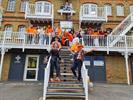Holmes Report 29 Jan 2012 // 12:00AM GMT
Social media is playing an important role in shaping news stories in general and crisis situations in particular. Specifically, even as social media makes it easy to track an emerging crisis situation, it makes it difficult to effectively manage the crisis situation.
Social media and the news curve
All news stories develop in a similar manner, following the news curve. The news curve has four stages: breaking news, context, analysis and archival. The breaking news stage is concerned with questions like: what happened, with whom and where? In the context stage, more information is added, as background. In the analysis stage, opinions are shared and responsibility is assigned. In the archival stage, the story goes off the newspaper front page, the website homepage and the evening news on TV.
Social media is playing an important role in shaping the news curve. The news curve is becoming shorter in the “breaking news” and “context” stages, but longer in the “analysis” and “archival” stages. The news curve is also becoming more fragmented and news stories are becoming more viral. Different social media behaviors play different roles across the four stages of the news curve. News stories are now being broken on the official Twitter channels of news organizations and shared via retweets. Context is being added by sharing links on Twitter using a hashtag. Blogs and video blogs are playing an important role in shaping opinion. Finally, search is making it easier to find and share archived stories that act as context for new stories.
The 26/11 Mumbai terror attack in 2009 is a good example of how social media is shaping the news ecosystem even in emerging economies. During the 72-hour terrorist seize of India’s financial capital, Twitter, Flickr and blogs became important tools for citizen journalists to share original reporting, news, and opinions. Social media, especially Twitter, played an important role in shaping the mainstream media narrative during the crisis, both in India and internationally.
Social media and the crisis curve
The four stages in the crisis curve correspond to the four stages in the news curve: flash point, spotlight, blame game and resolution. Like the news curve, the crisis curve is becoming shorter in the “flash point” and “spotlight” stages, but longer in the “blame game” and “resolution” stages. Like the news curve, the crisis curve is also becoming more fragmented and crisis stories are becoming more viral. As a result, even as social media makes it easy to track an emerging crisis situation, it makes it difficult to effectively manage the crisis situation.
The interplay between social media and mainstream media is an important aspect of the crisis curve, with online influencers linking to media stories and media quoting online influencers.
Three types of crisis situations
Based on the interplay between social media and mainstream media in the run up to the crisis flash point, crisis situations can be categorized into three types, each needing a different approach: real world crisis, slow burn crisis and flash mob crisis.
In the “real world” crisis, a real world incident (oil spill, financial scam, sex scandal) precipitates the crisis. Mainstream media puts a spotlight on the crisis while social media amplifies the crisis. For instance, during the protracted BP Gulf of Mexico crisis in 2010, the flash point was the oil spill itself, but social media played a critical role in the spotlight, blame game and resolution stages. BP’s crisis response was a textbook case study in terms of its scope and scale. However, a series of failed attempts to control the oil spill over months, then-CEO Tony Hayward’s “I want my life back” comment, and the online spoofs they inspired, did not help BP’s cause.
In the “slow burn” crisis, social media conversations (product quality, customer support, employee discontent) build up into a crisis and are picked up by influential bloggers and even mainstream media. For instance, in 2005, influential blogger Jeff Jarvis blogged about a series of bad customer service experiences with Dell, and became the focal point of the Dell Hell crisis. Dell Hell forced Dell to recommit to creating a positive customer experience and led to several remarkable social media initiatives including the Direct2Dell blog, the Dell Ideastorm ideation community and Dell’s social media command center.
In the “flash mob” crisis, a social media meme (Greenpeace campaign, anti-brand hashtag, anti-brand video) creates a flash mob, turns into a crisis, and is picked up by mainstream media. For instance, in 2010, Greenpeace created a viral video led campaign to protest against Nestle procuring palm oil from Indonesian rainforests and endangering orangutans. Protestors hijacked Nestle’s Facebook page and filled it with abusive comments and Nestle Killer profile pics. Surprisingly, Nestle’s strong corporate citizenship reputation for creating shared value did not help during the crisis. In the end, Nestlé announced that it would stop procuring from suppliers associated with deforestation.
Using social media to manage a crisis
Social media has a specific role to play at each stage of the crisis curve. MSLGROUP has created a crisis management toolkit that includes tools and best practices for each stage in the crisis cycle.
In the flash-point stage, we track negative social media chatter, identify early warning signals, isolate issues, and resolve them, before they turn into a crisis.
In the spotlight stage, we plot a heat map of crisis flows between social media and mainstream media, identify influencers who are acting as hubs driving these flows and focus our crisis management efforts on these hubs.
In the blame-game stage, we help clients shape the narrative by leveraging owned media channels like blog and YouTube to reframe the issue more positively and avert direct blame.
In the resolution stage, we optimize owned media content for search results, so that positive and neutral stories show up alongside negative stories on keyword searches related to the brand.
Most importantly, it’s critical to map out and plan for crisis scenarios in advance, in order to respond to them effectively. We have created a toolkit for mapping out alternate crisis scenarios and planning for their best, worst and most likely cases. This toolkit include a workshop for scenario, keyword, influencer, spokesperson and message mapping, and platforms like a wiki-based war room for crisis collaboration and a CMS-based dark site for crisis response.
In the end, however, managing any crisis successfully, including a crisis on social media, is less about saying the right things and more about doing the right things. So, corporations that are rooted in purpose are likely to respond to crisis situations with authenticity, and overcompensate for mistakes, transforming potential crises into opportunities to reconnect with their stakeholders.
Gaurav Mishra is director of social media for MSLGroup’s Asian operations.


































.jpg)

















